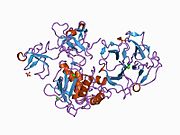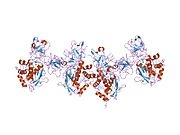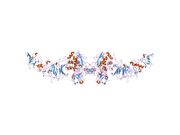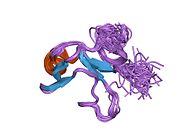Biology:MMP2
 Generic protein structure example |
72 kDa type IV collagenase also known as matrix metalloproteinase-2 (MMP-2) and gelatinase A is an enzyme that in humans is encoded by the MMP2 gene.[1] The MMP2 gene is located on chromosome 16 at position 12.2.[2]
Function
Proteins of the matrix metalloproteinase (MMP) family are involved in the breakdown of extracellular matrix (ECM) in normal physiological processes, such as embryonic development, reproduction, and tissue remodeling, as well as in disease processes, such as arthritis and metastasis. Most MMP's are secreted as inactive proproteins which are activated when cleaved by extracellular proteinases. This gene encodes an enzyme which degrades type IV collagen, the major structural component of basement membranes. The enzyme plays a role in endometrial menstrual breakdown, regulation of vascularization and the inflammatory response.[3]
Activation
Activation of MMP-2 requires proteolytic processing. A complex of membrane type 1 MMP (MT1-MMP/MMP14) and tissue inhibitor of metalloproteinase 2 recruits pro-MMP 2 from the extracellular milieu to the cell surface. Activation then requires an active molecule of MT1-MMP and auto catalytic cleavage. Clustering of integrin chains promotes activation of MMP-2. Another factor that will support the activation of MMP-2 is cell-cell clustering. A wild-type activated leukocyte cell adhesion molecule (ALCAM) is also required to activate MMP-2.
Clinical significance
Mutations in the MMP2 gene are associated with Torg-Winchester syndrome, multicentric osteolysis, arthritis syndrome,[4][5] and possibly keloids.
Role of MMP-2 in chronic disease
Activity of MMP-2 relative to the other gelatinase (MMP-9) has been associated with severity of chronic airway diseases including Idiopathic interstitial pneumonia and Bronchiectasis. In idiopathic interstitial pneumonia, MMP-2 activity was elevated in patients with the less severe disease phenotype which is more responsive and reversible with corticosteroid therapy.[6] In non-cystic fibrosis bronchiectasis, MMP-2 concentration was elevated in patients with Haemophilus influenzae airway infection compared to Pseudomonas aeruginosa airway infection.[7] Bronchiectasis patients with P. aeruginosa infection have a more rapid decline in lung function.[8] Disease-causing mutations in the MMP2 gene cause a rare type of skeletal dysplasia Multicentric Osteolysis, Nodulosis, and Arthropathy syndrome. Abnormal mutations cause defective collagen remodelling. The disease manifestations include bone destruction especially of the wrists and tarsus, generalized osteoporosis and joint stiffness and eventually destruction.[9][5]
Altered expression and activity levels of MMPs have been strongly implicated in the progression and metastasis of many forms of cancer. Increased MMP-2 activity has also been linked with a poor prognosis in multiple forms of cancer including colorectal, melanoma, breast, lung, ovarian, and prostate.[10] Furthermore, changes in MMP-2 activity can come from alterations in levels of transcription, MMP secretion, MMP activation, or MMP inhibition. MMP production in many cancers may be upregulated in surrounding stromal tissue rather than simply in the tumor lesion. For instance, Mook, et al. showed that MMP-2 mRNA levels are strikingly similar between metastatic and non-metastatic lesions in colorectal cancer, but metastatic cases are correlated with higher levels of MMP-2 mRNA in surrounding healthy tissue.[11] For this reason, it is difficult to fully understand the complex role of MMPs in cancer progression.
Role in cancer cell invasion
One of the major implications of MMPs in cancer progression is their role in ECM degradation, which allows cancer cells to migrate out of the primary tumor to form metastases. More specifically, MMP-2 (along with MMP-9) is capable of degrading type IV collagen, the most abundant component of the basement membrane. The basement membrane is important for maintaining tissue organization, providing structural support for cells, and influencing cell signaling and polarity. Degradation of the basement membrane is an essential step for the metastatic progression of most cancers.[11]
Cancer cell invasion, ECM degradation, and metastasis are highly linked with the presence of invadopodia, protrusive and adhesive structures on cancer cells. Invadopodia have been shown to concentrate MMPs (including MT1-MMP, MMP-2, and MMP-9) for localized release and activation.[12] Furthermore, degradation products of MMP activity may further promote invadopodia formation and MMP activity.[13] Finally, MMP-2 and several other MMPs have been shown to proteolytically activate TGF-β, which has been shown to promote epithelial mesenchymal transition (EMT), a key process involved in cancer metastasis.[14]
Role in cell signaling
MMP degradation of the ECM affects cellular behavior through changes in integrin-cell binding, by releasing growth factors harbored by the ECM, by generating ECM degradation products, and by revealing cryptic binding sites in ECM molecules.[15] For instance, MMP-2 degradation of collagen type I can reveal a previously inaccessible cryptic binding site that binds with the αvβ3 integrin expressed by human melanoma cells. Signaling through this integrin is necessary for melanoma cell viability and growth in a collagen matrix and can potentially rescue the cells from apoptosis.[16] As another example, cleavage of laminin-5, a component of the basement membrane, by MMP-2 has been shown to reveal a cryptic site inducing migration of breast epithelial cells.[17]
More generally, by degrading the ECM, MMPs release growth factors that were previously bound to the ECM, allowing them to bind with cell receptors and influence cell signaling. Furthermore, many MMPs also activate other proMMPs along with growth factors.[15] MMP-2 has also been shown to cleave other non-ECM substrates including growth factors such as TGF-β, FGF receptor-1, proTNF, IL-1β and various chemokines.[18] For instance, MMP-2 has been implicated, along with MMP-9 in cleaving latent TGF-β, which has complex interactions with cancer cells. TGF-β generally plays a role in maintaining tissue homeostasis and preventing tumor progression. However, genetically unstable cancer cells can often evade regulation by TGF-β by altering TGF-β receptors in downstream signaling processes. Furthermore, expression of TGF-β is also correlated with immune tolerance and may help shield cancer cells from immune regulation.[19]
Role in neovascularization and lymphangiogenesis
MMP-2 also plays an important role in the formation of new blood vessels within tumors, a process known as angiogenesis. This process is essential for tumor progression, because as tumors grow they need increasing supplies of oxygen and nutrients. Localized MMP-2 activity plays an important role in endothelial cell migration, a key feature of angiogenesis. Additionally, MMP-9 and other MMPs have been suggested to also play a complex, indirect role in angiogenesis by promoting VEGF mobilization and generating antiangiogenic factors.[11]
For instance, when studying carcinogenesis of pancreatic islets in transgenic mice, Bergers et al. showed that MMP-2 and MMP-9 were upregulated in angiogenic lesions and that the upregulation of these MMPs triggered the release of bioactive VEGF, a potent stimulator of angiogenesis. Additionally, the group determined that MMP-2 knockout mice showed decreased rates of tumor growth relative to tumor growth rates in wild type mice.[20] Furthermore, increased expression and activity of MMP-2 has been tied to increased vascularization of lung carcinoma metastases in the central nervous system, which likely increases survival rate of these metastases.[21]
Finally, MMP-2 has been also shown to drive lymphangiogenesis, which is often excessive in tumor environments and can provide a route of metastasis for cancer cells. Detry, et al. showed that knocking down mmp2 in zebrafish prevented the formation of lymphatic vessels without altering angiogenesis, while MMP-2 inhibition slowed the migration of lymphatic endothelial cells and altered the morphology of new vessels.[11] These results suggest that MMP-2 may alter tumor viability and invasion by regulating lymphangiogenesis in addition to angiogenesis.
Inhibition of MMP-2 as cancer therapy
Clinical trials for cancer therapies using MMP inhibitors have yielded generally unsuccessful results. These poor results are likely due to the fact that MMPs play complex roles in tissue formation and cancer progression, and indeed many MMPs have both pro and anti-tumorogenic properties. Furthermore, most clinical studies involve advanced stages of cancer, where MMP inhibitors are not particularly effective. Finally, there are no reliable biomarkers available for assessing the efficacy of MMP inhibitors and MMPs are not directly cytotoxic (so they do not cause tumor shrinkage), so it is difficult for researchers to determine whether the inhibitors have successfully reached their targets.[10]
However, initial clinical trials using broad spectrum MMP inhibitors did show some positive results. Phase I clinical trials showed that MMP inhibitors are generally safe with minimal adverse side effects. Additionally, trials with marimastat did show a slight increase in survival of patients with gastric or pancreatic cancer.[10]
Various research groups have already suggested many strategies for improving the effectiveness of MMP inhibitors in cancer treatment. First, highly specific MMP inhibitors could be used to target the functions of specific MMPs, which should allow doctors to increase the treatment dosage while minimizing adverse side effects. MMP inhibitors could also be administered along with cytotoxic agents or other proteinase inhibitors. Finally, MMP inhibitors could be used during earlier stages of cancer to prevent invasion and metastasis.[10]
Additionally, tumor overexpression of MMPs can be used to potentially target the release of chemotherapeutic agents specifically to tumor sites. For instance, cytotoxic agents or siRNA could be encapsulated in liposomes or viral vectors that only become activated upon proteolytic cleavage by a target MMP. Finally, the tumor-targeting properties of MMP inhibitors offer a potential strategy for identifying small tumors. Researchers could couple MMP inhibitors to imaging agents to help detect tumors before they spread. Though initial trials yielded disappointing results, MMP inhibitors offer significant potential for improving cancer treatment by slowing the process of cancer cell invasion and metastasis.[10]
Interactions
MMP2 has been shown to interact with:
References
- ↑ "Structure and expression of neutrophil gelatinase cDNA. Identity with type IV collagenase from HT1080 cells". J. Biol. Chem. 267 (35): 25228–32. December 1992. doi:10.1016/S0021-9258(19)74029-0. PMID 1460022.
- ↑ "MMP2 gene". http://ghr.nlm.nih.gov/gene/MMP2.
- ↑ "Entrez Gene: MMP2 matrix metallopeptidase 2 (gelatinase A, 72kDa gelatinase, 72kDa type IV collagenase)". https://www.ncbi.nlm.nih.gov/sites/entrez?Db=gene&Cmd=ShowDetailView&TermToSearch=4313.
- ↑ "Mutation of the matrix metalloproteinase 2 gene (MMP2) causes a multicentric osteolysis and arthritis syndrome". Nature Genetics 28 (3): 261–5. July 2001. doi:10.1038/90100. PMID 11431697.
- ↑ 5.0 5.1 "Multicentric Osteolysis, Nodulosis, and Arthropathy in two unrelated children with matrix metalloproteinase 2 variants: Genetic-skeletal correlations". Bone Reports 15: 101106. December 2021. doi:10.1016/j.bonr.2021.101106. PMID 34307793.
- ↑ "Characteristic elevation of matrix metalloproteinase activity in idiopathic interstitial pneumonias". American Journal of Respiratory and Critical Care Medicine 162 (5): 1949–56. November 2000. doi:10.1164/ajrccm.162.5.9906096. PMID 11069839.
- ↑ "Matrix metalloproteinases vary with airway microbiota composition and lung function in non-cystic fibrosis bronchiectasis". Annals of the American Thoracic Society 12 (5): 701–7. May 2015. doi:10.1513/AnnalsATS.201411-513OC. PMID 25679336.
- ↑ "A novel microbiota stratification system predicts future exacerbations in bronchiectasis". Annals of the American Thoracic Society 11 (4): 496–503. May 2014. doi:10.1513/AnnalsATS.201310-335OC. PMID 24592925.
- ↑ "Clinical and mutation profile of multicentric osteolysis nodulosis and arthropathy". American Journal of Medical Genetics. Part A 170A (2): 410–417. February 2016. doi:10.1002/ajmg.a.37447. PMID 26601801.
- ↑ 10.0 10.1 10.2 10.3 10.4 "Gelatinase-mediated migration and invasion of cancer cells". Biochimica et Biophysica Acta (BBA) - Reviews on Cancer 1755 (1): 37–69. May 2005. doi:10.1016/j.bbcan.2005.03.001. PMID 15907591.
- ↑ 11.0 11.1 11.2 11.3 "The role of gelatinases in colorectal cancer progression and metastasis". Biochimica et Biophysica Acta (BBA) - Reviews on Cancer 1705 (2): 69–89. December 2004. doi:10.1016/j.bbcan.2004.09.006. PMID 15588763.
- ↑ "The regulation of MMP targeting to invadopodia during cancer metastasis". Frontiers in Cell and Developmental Biology 3: 4. 2015. doi:10.3389/fcell.2015.00004. PMID 25699257.
- ↑ "Cortactin is an essential regulator of matrix metalloproteinase secretion and extracellular matrix degradation in invadopodia". Cancer Research 67 (9): 4227–35. May 2007. doi:10.1158/0008-5472.CAN-06-3928. PMID 17483334.
- ↑ "Roles of matrix metalloproteinases in cancer progression and their pharmacological targeting". The FEBS Journal 278 (1): 16–27. Jan 2011. doi:10.1111/j.1742-4658.2010.07919.x. PMID 21087457.
- ↑ 15.0 15.1 "Matrix metalloproteinases: multifunctional contributors to tumor progression". Molecular Medicine Today 6 (4): 149–56. April 2000. doi:10.1016/s1357-4310(00)01686-5. PMID 10740253.
- ↑ "Integrin alpha v beta 3 rescues melanoma cells from apoptosis in three-dimensional dermal collagen". Proceedings of the National Academy of Sciences of the United States of America 91 (19): 8856–60. September 1994. doi:10.1073/pnas.91.19.8856. PMID 7522323. Bibcode: 1994PNAS...91.8856M.
- ↑ "Induction of cell migration by matrix metalloprotease-2 cleavage of laminin-5". Science 277 (5323): 225–28. July 1997. doi:10.1126/science.277.5323.225. PMID 9211848.
- ↑ "Matrix metalloproteinase-2 governs lymphatic vessel formation as an interstitial collagenase". Blood 119 (21): 5048–56. May 2012. doi:10.1182/blood-2011-12-400267. PMID 22490679. https://dipot.ulb.ac.be/dspace/bitstream/2013/261407/4/zh802112005048.pdf.
- ↑ "TGFbeta in Cancer". Cell 134 (2): 215–30. July 2008. doi:10.1016/j.cell.2008.07.001. PMID 18662538.
- ↑ "Matrix metalloproteinase-9 triggers the angiogenic switch during carcinogenesis". Nature Cell Biology 2 (10): 737–44. October 2000. doi:10.1038/35036374. PMID 11025665.
- ↑ "Expression of MMP-2 correlates with increased angiogenesis in CNS metastasis of lung carcinoma". International Journal of Clinical and Experimental Pathology 3 (8): 775–81. 2010. PMID 21151391.
- ↑ "Inflammation dampened by gelatinase A cleavage of monocyte chemoattractant protein-3". Science 289 (5482): 1202–6. August 2000. doi:10.1126/science.289.5482.1202. PMID 10947989. Bibcode: 2000Sci...289.1202M.
- ↑ 23.0 23.1 "Thrombospondin type 1 repeats interact with matrix metalloproteinase 2. Regulation of metalloproteinase activity". J. Biol. Chem. 275 (41): 32167–73. October 2000. doi:10.1074/jbc.M003834200. PMID 10900205.
- ↑ "Structural insight into the complex formation of latent matrix metalloproteinase 2 with tissue inhibitor of metalloproteinase 2". Proc. Natl. Acad. Sci. U.S.A. 99 (11): 7414–9. May 2002. doi:10.1073/pnas.102185399. PMID 12032297. Bibcode: 2002PNAS...99.7414M.
- ↑ "Domain interactions in the gelatinase A.TIMP-2.MT1-MMP activation complex. The ectodomain of the 44-kDa form of membrane type-1 matrix metalloproteinase does not modulate gelatinase A activation". J. Biol. Chem. 275 (50): 39497–506. December 2000. doi:10.1074/jbc.M005932200. PMID 10991943.
- ↑ 26.0 26.1 "Specific, high affinity binding of tissue inhibitor of metalloproteinases-4 (TIMP-4) to the COOH-terminal hemopexin-like domain of human gelatinase A. TIMP-4 binds progelatinase A and the COOH-terminal domain in a similar manner to TIMP-2". J. Biol. Chem. 272 (24): 15496–500. June 1997. doi:10.1074/jbc.272.24.15496. PMID 9182583.
- ↑ 27.0 27.1 "Utilization of a novel recombinant myoglobin fusion protein expression system to characterize the tissue inhibitor of metalloproteinase (TIMP)-4 and TIMP-2 C-terminal domain and tails by mutagenesis. The importance of acidic residues in binding the MMP-2 hemopexin C-domain". J. Biol. Chem. 277 (50): 48696–707. December 2002. doi:10.1074/jbc.M209177200. PMID 12374789.
Further reading
- "Matrix metalloproteinases: structures, evolution, and diversification". FASEB J. 12 (25n26): 1075–95. 1998. doi:10.1142/S0217984998001256. PMID 9737711.
- "Matrix metalloproteinases". J. Biol. Chem. 274 (31): 21491–4. 1999. doi:10.1074/jbc.274.31.21491. PMID 10419448.
- "Human endometrial epithelial cells modulate the activation of gelatinase a by stromal cells". Gynecol. Obstet. Invest. 53 (2): 105–11. 2002. doi:10.1159/000053003. PMID 11961384.
- "[Type IV collagenases (MMP-2 and MMP-9) and their substrates--intracellular proteins, hormones, cytokines, chemokines and their receptors]". Postepy Biochem. 53 (1): 37–45. 2007. PMID 17718386.
External links
 |








